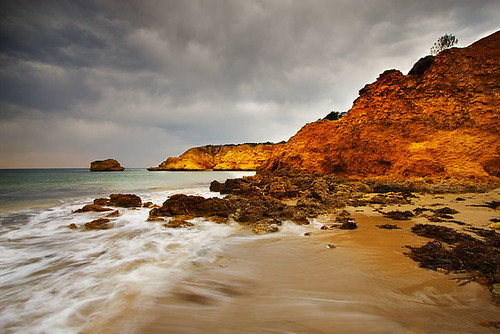By Darren Stones
When travelling to photograph those picture perfect locations like you see in the guidebooks, you need Mother Nature on your side to help you get the shots that you want. Everyone loves seeing images with blue skies and a few clouds, but what happens when you arrive, your time is limited, and the weather is overcast?
Research
Travel photographers usually research their chosen locations before heading off and try their best to arrive in locations when the weather conditions are suitable for attractive photography. But things do not always go according to plan.
Recently I spent some time on the Surf Coast in Victoria, and was scouting around the base of the cliff face at Rocky Point at Torquay. It is a great looking area adjacent to the Torquay Surf Club when the sun is shining – particularly in the morning.
On my first day in the area, I decided to go out during the afternoon to check out some potential spots for making landscape photographs. With the clouds looking ominous, a few spots of rain began to fall. Lots of people were around on the beach to that point, and then they decided to scatter. Suited me fine, as the clouds were beginning to look more interesting and I thought I could use them to my advantage.
Filters
With the use of my polariser and graduated neutral density filters, I was able to even out the lighting and use a slow shutter speed. This allowed me to use my creativity and create an image where I could blur the water. My shoes got absolutely soaked whilst taking this shot, as I had my camera set up on my tripod on a small rock shelf and some waves were still coming over the rocks. However, I thought it was worth the effort to photograph the scene, so continued on regardless. It was safe to do so as the tide was going out.
Creativity
So my advice to photographers is that when the weather begins to turn sour, don't run for cover so quickly. Stay behind and work the area with your creative hat on. By using a tripod you will be giving yourself time to slow down and analyse the scene, plus use those slower shutter speeds to create the sense of movement in the water.
If the rain is just a few spots, like it was for me during this shoot, protect your camera with a small cover such as a handkerchief. It worked fine for me and I left satisfied at having created a new photograph.
Photograph details:
Camera: Canon EOS 20D Body
Lens: Canon EF-S 10-22mm f/3.5-4.5 USM Lens
Filters: Polariser, Lee Graduated Neutral Density .9ND G S
Exposure: f/16, 0.8sec, ISO-100, RAW
Other: Manfrotto 190PROB Tripod, Canon Remote Switch RS-80N3


Love your advise Darren, thanks.
ReplyDeleteI should really follow your post more often.
Sylvain Allard
It's been a while since we've completed the travel writing and photography course.
Hi Sylvain,
ReplyDeleteThanks for dropping by. Trust the info comes in handy.
Yes, a few years have passed since we studied the course, and I have fond memories.
I see you're producing some nice images, and checked them out on Flickr. Good work.
Feel free to check back here every so often as I put some info up here which may be of interest. Heaps of content in this site now, so you may find a gem or two. :)
Cheers,
Darren